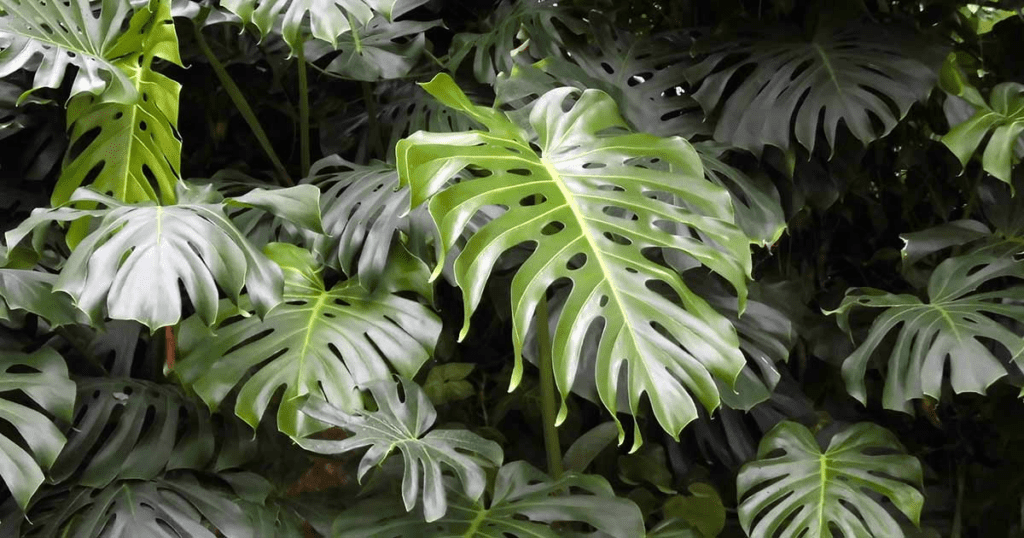How To Grow And Care For Monstera Obliqua In Your Backyard?
If you’re looking to grow the rarest and most expensive house plants then it’s time to keep your fingers on Monstera Obliqua. Serious gardeners tend to grow this variety in their home garden. Hey folks! I’m Anna Scott, a Gardener by heart and Profession, started my Journey 15 years ago and Now I am teaching other gardeners as well to achieve their goals.
The Monstera Obliqua is a small variety of monstera that will add a magical look to your home garden. It is not only rare but is an expensive variety to find. being a tropical house plant, it develops broad-shaped and large leaves in the plant. It is not difficult to maintain plants and also adds tropical display to your area. People usually get confused between the Monstera Adansonii and the Monstera Obliqua (They resemble each other).
In the guide, you will come to know about this beautiful houseplant’s growing and caring requirements. So let’s get started to know about how to grow and care for Monstera Obliqua in detail.
| Common Name | Monstera obliqua |
| Botanical Name | Monstera obliqua |
| Family | Araceae |
| Plant Type | Perennial |
| Mature Size | 6-10 ft. tall (outdoors), 4-5 ft. tall (indoors) |
| Sun Exposure | Indirect, full light |
| Soil Type | Moist but well-drained |
| Soil pH | Acidic |
| Bloom Time | Spring, summer |
| Flower Color | Green, white, yellow |
| Hardiness Zones | 9-11, USDA |
| Native Area | Central America, South America |
| Toxicity | Toxic to pets |
How to Grow And Care for Monstera Obliqua?
It is an easy-to-grow plant but requires little maintenance to grow healthy. Every plant requires proper maintenance so that it produces healthy foliage in the plant.

The monstera obliqua plant Will grow best in warm and humid conditions which is only possible with the help of a terrarium or greenhouse.
It is said that the plant grows best if it is in the right climatic conditions. So let’s get started to throw some light on the growing and caring guide for Monstera Obliqua. They are as follows:
Light
- This variety requires about seven hours of bright indirect sunlight to grow.
- Do not expose the plant to direct sunlight as the leaves will begin to wilt, and the whole foliage will be spoiled.
- If you’re growing it indoors, then make use of grow lights as they will supply the required sunlight to the plants.
- It is also suggested to grow this plant in the terrariums or the greenhouse cabinets, it will help in avoiding direct supply of sunlight.
Soil
- This plant requires a well-drained soil mix to grow well. Also retaining the mixture will suit the plant’s growth.
- Add some perlite to the soil mix and sphagnum moss on its top, it will help in providing moisture and a good humidity level to the plant.
- Adding bark to the loamy soil will also be a good choice for the monstera obliqua.
Water
- this plant likes to remain moist but not waterlogged soil as it will cause fungus infection in the plant like root rot.
- Let the soil dry between waterings. So water the plant when the top inches of the soil become fully dry.
- For that, it is required to check the moisture of the soil by inserting the finger inside the soil about 1 to 2 inches deep.
- If it feels dry, then is the right time to water your plant. But do not overwater the plant if the soil is already moist.
- Water the plant one time in a week when it is actively growing. So, follow a strict watering schedule for the plant.
- During fall, reduce the watering especially in the winter months because the plant is in its dormant period at that time.
God Almighty first planted a garden. And indeed, it is the purest of human pleasures.
-Francis Bacon
Temperature and Humidity
- This plant requires proper temperature and humidity to grow well. The ideal range of humidity for this plant is about 80%.
- The ideal level of temperature is around 77°F or 25°C.
- If the plant does not receive this amount of humidity and temperature, then it will develop thin leaves in the plant which will die with time.
- It shows that the plant needs a greenhouse cabinet or terrarium to grow well where the conditions are controlled with the help of a humidifier.

Fertilizer
- Being a rare plant, it grows slowly in the home garden, so it requires less fertilizer as compared to other plants.
- So provide water-soluble fertilizer to the plant and dilute it with water to its half strength.
- It will avoid over-fertilisation in the plant. Also, apply the fertilizer once a month when the plant is growing activity the spring and summer seasons.
- Do not fertilize the plant during winter as the plant is in its dormant period at that time.
Types of Monstera Obliqua
There are various types of monstera available in the market. But 15 popular varieties of monstera obliqua have been discovered till now. So let’s have a glimpse of those varieties. They are as follows:
- Monstera obliqua ‘Peru’
- Monstera obliqua ‘Bolivia’
- Monstera obliqua ‘Suriname’
- Monstera obliqua ‘Panama’
- Monstera obliqua ‘Filamentous’
- Monstera obliqua ‘Brazil’

Propagating Monstera Obliqua
As I already explained to you, stem cuttings are the best way to propagate a plant and the same is the case with Monstera obliqua which can be easily grown with the help of stem cuttings that you will pinch off from the mother plant.
So let’s get started to know the steps to know how to propagate monstera obliqua. They are as follows:
- First, make use of clean and sharp sterilized scissors to take the stem cuttings from the mother plant.
- Then cut stem cuttings from the mother plant that should contain 2 to 3 nodes in every cutting.
- Remove the leaves from the base of the nodes and the remaining leaves in the cuttings.
- Then put the cuttings in the container that is filled with water at the bottom and leave the leaves above the water.
- Place your cuttings at a location where they can receive plenty of bright, indirect sunlight.
- Water the pothos one time a week so that they grow well. After 15 to 20 days you will observe tiny roots that emerge from the nodes.
- Then when it becomes 1 inch long, move it in the soil by making use of a well-drained potting mix for your plant.
- By planting the cutting in the soil, keep in mind to water the plant till the excess water flows out from the drainage holes.
- Place the plant in bright indirect sunlight so that it grows well and then resume watering after 10 to 15 days.
Potting and Repotting
- Being a slow grower, it does not require to be repotted every year. So, repot the plant when it overgrows and its roots are coming out from the drainage holes.
- Repot this plant during the summer and spring seasons when the plant grows actively.
- Also, make use of a new pot that is 1-2 inches bigger than the current pot and fresh potting mix for your plant.
- Make sure the pot has a good amount of drainage holes as it will help in better drainage.

Common Pests
The Monstera obliqua is a rare house plant that also attracts various pests that are harmful to the plant’s growth. These pests include spider mites, scale, whiteflies, thrips, fungus gnats, etc.
Usually, this problem came into existence. If you have grown this variety in the terrarium or the greenhouse cabinet.
This is because there the pest spreads more easily and covers the whole space. Last, but not least keep a check on the pests to ruin them so that the plants get saved. Make use of mild insecticides to the plant daily, which will remove all the pests.
Common Problems With Monstera Obliqua
This plant faces various common problems. Though you are caring for your plant, but then also it is important to maintain the growth of the plant. So let’s have a look at some common problems of monstera obliqua in detail. They are as follows:
Yellow Leaves
- This plant tends to produce yellow color leaves, which shows that the plant is facing some issues.
- Also, it happens due to overwatering, exposure to too much sunlight, Pests, underwatering, etc.
- So it is important to have a look at the plant to see what’s going on in the plant daily.

Root Rot
- Root rot is another common problem faced by the monstera obliqua. Its signs include yellow-colored leaves, mushy stems, dead roots, etc.
- Root rot happens because of the oversupply of water to the plants.
- So if you see that the plant is suffering from root rot, then remove all dead leaves from the plant.
- Also, you can repot the plant by making use of fresh potting mix.
Dry Leaves
- Dry leaves also indicate that the plant is suffering from some common problems which is not good for its health.
- If there is a lack of humidity in the plant, then leaves will begin to dry out faster.
- So the best way to recover this problem is to provide a good amount of humidity to the plant which is about 80%.
Summing up the Context
In this guide, you come to know that The Monstera Obliqua is a small variety of monstera that will add a magical look to your home garden. It is not only rare but is an expensive variety to find. being a tropical house plant, it develops broad-shaped and large leaves in the plant. It is not difficult to maintain this plant and also adds a tropical display to your area.
People usually get confused between the Monstera Adansonii and the Monstera Obliqua (They resemble each other). I hope you are clear with the growing and caring guide of Monstera Obliqua. Enjoy the variety and I will come back with another informative guide soon till then safe gardening.
Thanks for reading! Happy Gardening!
FAQs
Is Monstera Obliqua still rare?
Yes, this variety is a rare variety to find. You can grow it easily in your home garden.
Is Monstera Obliqua an indoor plant?
Yes, monstera obliqua is a house plant that tends to produce large and broad-shaped leaves in the plant with holes in them. It produces larger varieties as compared to other monstera varieties. It adds a texture look to the whole garden.
Why Monstera is expensive?
This plant requires great skills to grow because it tends to produce less chlorophyll which affects the photosynthesis in the plant. So this heavy-demand plant requires some sort of skills because of its rare nature and expensive


